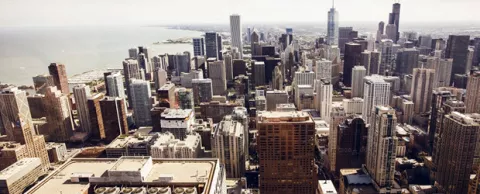
The Smart Cities Council has routinely advised cities to consider smart street lighting projects as part of their smart city planning. Replacing older lighting with smart LED lights offers not only better illumination for streets and other public areas and dramatic savings in energy costs, it can also serve as a platform to support additional applications cities may want to add in the future (including environmental sensors and electric vehicle charging). Chicago's lighting project is a good example of the benefits smart street lighting provides, as our story explains. However, there's an additional takeaway for other cities considering lighting projects: Chicago focused the deployment on high crime areas first. — Doug Peeples
The city of Chicago expects to save its citizens about $100 million over the next 10 years because its new smart streetlight network will cut energy and maintenance costs by that much.
The city's Smart Lighting Project will see to the replacement of 270,000 street, viaduct and alley lights throughout the city over the course of the four-year program. The city has already installed 76,000 smart LED streetlights in the first year of the program, replacing its old high-pressure sodium lamps.
Benefits
Implemented by the Chicago Department of Transportation (CDOT), the new lights are expected to provide better visibility with lighting that will be directed downward to avoid sending stray light into the night sky and the windows of nearby buildings, and the lights also generate less glare than sodium lighting. The new city-owned and operated lights use 50-75% less energy and have a life span two to three times longer than the old lighting, which accounts for the energy and maintenance cost savings. Also, the city should qualify for energy efficiency rebates that could total $35 million from electric utility ComEd for installing the more efficient lights.
A lighting management system also is being installed which will send alerts when service is needed once it is operating later in the year.
Public safety part of the program strategy — from the beginning
Whether improved street lighting reduces crime significantly has been debated, but a New York City study cited by the University of Chicago's Urban Labs found that better lighting reduced serious felony crimes committed at night by 39%.
And that's relevant to Chicago's lighting upgrade. Rather than focus exclusively on the most populated or well-traveled areas, the deployments during the project's first year focused on the city's most dangerous areas. As Mayor Rahm Emanuel's press release announcing the one-year milestone said, "Streetlight fixture replacements in the first year have been focused in South and West Side neighborhoods with heightened public safety concerns."
The South Side is home to the University of Chicago, Chinatown and the Museum of Science and Technology. However, some of its neighborhoods are considered the most dangerous in the city. And the West Side, known for a bustling nightlife and entertainment, also contains pockets of dangerous neighborhoods.
While upgraded lighting also was installed along more than a dozen major arterials and Lake Shore Drive during the project's first year, Chicago's initial focus on problem areas is an example other cities could learn from.
Doug Peeples is a Portland, Oregon-based writer specializing in technology and energy. Follow @smartccouncil on Twitter.



